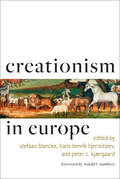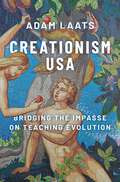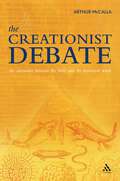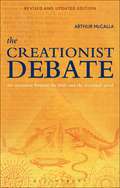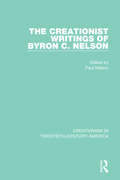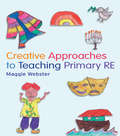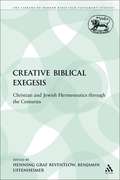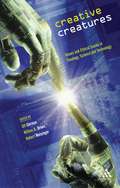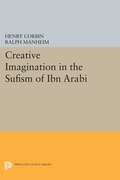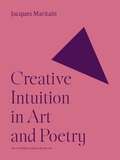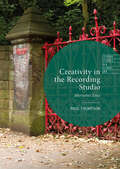- Table View
- List View
Creationism in Europe (Medicine, Science, and Religion in Historical Context)
by Stefaan Blancke Hans Henrik Hjermitslev Peter C. KjærgaardFor decades, the creationist movement was primarily situated in the United States. Then, in the 1970s, American creationists found their ideas welcomed abroad, first in Australia and New Zealand, then in Korea, India, South Africa, Brazil, and elsewhereâ€�including Europe, where creationism plays an expanding role in public debates about science policy and school curricula. In this, the first comprehensive history of creationism in Europe, leading historians, philosophers, and scientists narrate the rise ofâ€�and response toâ€�scientific creationism, creation science, intelligent design, and organized antievolutionism in countries and religions throughout Europe.Providing a unique map of creationism in Europe, the authors chart the surprising history of creationist activities and strategies there. Over the past forty years, creationism has spread swiftly among European Catholics, Protestants, Jews, Hindus, and Muslims, even as anti-creationists sought to smother its flames. Antievolution messages gained such widespread approval, in fact, that in 2007 the Parliamentary Assembly of the Council of Europe passed a resolution advising member states to "defend and promote scientific knowledge" and "firmly oppose the teaching of creationism as a scientific discipline on an equal footing with the theory of evolution." Creationism in Europe offers a discerning introduction to the cultural history of modern Europe, the variety of worldviews in Europe, and the interplay of science and religion in a global context. It will be of interest to students and scholars in the history and philosophy of science, religious studies, and evolutionary theory, as well as policy makers and educators concerned about the spread of creationism in our time.
Creationism USA: Bridging the Impasse on Teaching Evolution
by Adam LaatsWho are America's creationists? What do they want? Do they truly believe Jesus rode around on dinosaurs, as sometimes depicted? Creationism USA reveals how common misconceptions about creationism have led Americans into a century of unnecessary culture-war histrionics about evolution education and creationism. Adam Laats argues that Americans do not have deep, fundamental disagreements about evolution - not about the actual science behind it and not in ways that truly matter to public policy. Laats asserts that Americans do, however, have significant disagreements about creationism. By describing the history of creationism and its many variations, Laats demonstrates that the real conflict about evolution is not between creationists and evolution. The true landscape of American creationism is far more complicated than headlines suggest. Creationism USA digs beyond those headlines to prove two fundamental facts about American creationism. First, almost all Americans can be classified as creationists of one type or another. Second, nearly all Americans (including self-identified creationists) want their children to learn mainstream evolutionary science. Taken together, these truths about American creationism point to a large and productive middle ground, a widely shared public vision of the proper relationship between schools, science, and religion. Creationism USA both explains the current state of America's battles over creationism and offers a nuanced yet straight-forward prescription to solve them.
Creationism USA: Bridging the Impasse on Teaching Evolution
by Adam LaatsWho are America's creationists? What do they want? Do they truly believe Jesus rode around on dinosaurs, as sometimes depicted? Creationism USA reveals how common misconceptions about creationism have led Americans into a century of unnecessary culture-war histrionics about evolution education and creationism. Adam Laats argues that Americans do not have deep, fundamental disagreements about evolution - not about the actual science behind it and not in ways that truly matter to public policy. Laats asserts that Americans do, however, have significant disagreements about creationism. By describing the history of creationism and its many variations, Laats demonstrates that the real conflict about evolution is not between creationists and evolution. The true landscape of American creationism is far more complicated than headlines suggest. Creationism USA digs beyond those headlines to prove two fundamental facts about American creationism. First, almost all Americans can be classified as creationists of one type or another. Second, nearly all Americans (including self-identified creationists) want their children to learn mainstream evolutionary science. Taken together, these truths about American creationism point to a large and productive middle ground, a widely shared public vision of the proper relationship between schools, science, and religion. Creationism USA both explains the current state of America's battles over creationism and offers a nuanced yet straight-forward prescription to solve them.
The Creationist Debate: The Encounter between the Bible and the Historical Mind
by Arthur McCallaThis book places the present Creationist opposition to the theory of evolution in historical context by setting out the ways in which, from the seventeenth century onwards, investigations of the history of the earth and of humanity have challenged the biblical views of chronology and human destiny, and the Christian responses to these challenges. The author's interest is not primarily directed to questions such as the epistemological status of scientific versus religious knowledge or the possibility of a Darwinian ethics, but rather to the problems, and various responses to the problems, raised in a particular historical period in the West for the Bible by the massive extension of the duration of geological time and human history.
The Creationist Debate, Second Edition: The Encounter between the Bible and the Historical Mind
by Arthur McCallaWhereas scholarly study of Creationism usually places it in the context of religion and the history or philosophy of science, The Creationist Debate, here revised and completely updated in its second edition, has been written in the conviction that creationism is ultimately about the status of the Bible in the modern world. Creationism as a modern ideology exists in order to defend the authority of the Bible as a repository of transhistorical truth from the challenges of any and all historical sciences. It belongs to and is inseparable from Protestant Fundamentalists' desire to resubject the modern world to the authority of the inerrant Bible. Intelligent Design creationism, to the extent that it distinguishes itself from reactionary biblicism, is a program advocating a supernaturalist, providentialist understanding of the world. Accordingly, The Creationist Debate situates Creationism and Intelligent Design in relation to the rise, from the early modern period onwards, of historical thinking in various scientific and scholarly disciplines (including theories of the earth, chronology, civil history, geology, biblical criticism, paleontology, evolutionary biology, and anthropology) in their complex relationship to the status of the Bible as an historical authority. It argues that the debate over Creationism is at bottom a debate over how to interpret the biblical text rather than over how to interpret the world.
The Creationist Debate, Second Edition: The Encounter between the Bible and the Historical Mind
by Arthur McCallaWhereas scholarly study of Creationism usually places it in the context of religion and the history or philosophy of science, The Creationist Debate, here revised and completely updated in its second edition, has been written in the conviction that creationism is ultimately about the status of the Bible in the modern world. Creationism as a modern ideology exists in order to defend the authority of the Bible as a repository of transhistorical truth from the challenges of any and all historical sciences. It belongs to and is inseparable from Protestant Fundamentalists' desire to resubject the modern world to the authority of the inerrant Bible. Intelligent Design creationism, to the extent that it distinguishes itself from reactionary biblicism, is a program advocating a supernaturalist, providentialist understanding of the world. Accordingly, The Creationist Debate situates Creationism and Intelligent Design in relation to the rise, from the early modern period onwards, of historical thinking in various scientific and scholarly disciplines (including theories of the earth, chronology, civil history, geology, biblical criticism, paleontology, evolutionary biology, and anthropology) in their complex relationship to the status of the Bible as an historical authority. It argues that the debate over Creationism is at bottom a debate over how to interpret the biblical text rather than over how to interpret the world.
The Creationist Writings of Byron C. Nelson
by Paul NelsonOriginally published in 1995 this is the fifth volume in the series Creationism in 20th Century America. It re-publishes After Its Kind – a critique on theories of biological evolution and a defense of the biblical account of creation which Nelson wrote when he was a Pastor in New Jersey where he also attended classes in genetics and zoology at Rutgers university. His 1931 volume The Deluge Story in Stone: A History of the Flood Theory of Geology, also reprinted here was continuously in print until the 1960s. As his scientific and theological correspondence expanded in the wake of his publications, Nelson became further involved in the ‘evolution debates’. During the late 1930s his writings concentrated on early man and the glacial phenomena he saw all about him in Wisconsin and he compiled the materials he thought necessary to relate Scripture to the evidence of human antiquity.
The Creationist Writings of Byron C. Nelson
by Paul NelsonOriginally published in 1995 this is the fifth volume in the series Creationism in 20th Century America. It re-publishes After Its Kind – a critique on theories of biological evolution and a defense of the biblical account of creation which Nelson wrote when he was a Pastor in New Jersey where he also attended classes in genetics and zoology at Rutgers university. His 1931 volume The Deluge Story in Stone: A History of the Flood Theory of Geology, also reprinted here was continuously in print until the 1960s. As his scientific and theological correspondence expanded in the wake of his publications, Nelson became further involved in the ‘evolution debates’. During the late 1930s his writings concentrated on early man and the glacial phenomena he saw all about him in Wisconsin and he compiled the materials he thought necessary to relate Scripture to the evidence of human antiquity.
Creative Approaches to Teaching Primary RE
by Maggie WebsterAs an increasingly significant aspect of primary teaching, Creative Approaches to Teaching Primary RE is the essential companion to help bring creativity to life in the classroom. The text begins with a discussion of creative education and the value of Religious Education, moving on to reflect on the cross-curricular nature of the subject, exploring ways of introducing creativity to the classroom, through the medium of Religious Education. Each chapter provides ideas and activities demonstrating how pedagogy and theory can be applied in practice within a school setting. The inclusion of case studies will help you consider how to develop creative approaches in all curriculum areas. This book invites you to ask questions such as:· What is Creative Education?· Why should RE be included in the ever-changing curriculum?· How can I use Religious Education to generate a more creative environment in the classroom?
Creative Approaches to Teaching Primary RE
by Maggie WebsterAs an increasingly significant aspect of primary teaching, Creative Approaches to Teaching Primary RE is the essential companion to help bring creativity to life in the classroom. The text begins with a discussion of creative education and the value of Religious Education, moving on to reflect on the cross-curricular nature of the subject, exploring ways of introducing creativity to the classroom, through the medium of Religious Education. Each chapter provides ideas and activities demonstrating how pedagogy and theory can be applied in practice within a school setting. The inclusion of case studies will help you consider how to develop creative approaches in all curriculum areas. This book invites you to ask questions such as:· What is Creative Education?· Why should RE be included in the ever-changing curriculum?· How can I use Religious Education to generate a more creative environment in the classroom?
Creative Biblical Exegesis: Christian and Jewish Hermeneutics through the Centuries (The Library of Hebrew Bible/Old Testament Studies)
by Henning Graf Reventlow Benjamin UffenheimerThese papers were presented to a unique conference held in Israel in December 1985, sponsored by Tel Aviv University and the University of Bochum in the Federal Republic of Germany. Discussion of Christian and Jewish exegesis in historical perspective was not only mutually illuminating, but also laid the foundations for a new level of Jewish-Christian dialogue. The papers presented in this volume are: H. Graf Reventlow, Humanist Exegesis: The famous Hugo Grotius. Y. Hoffman, The Technique of Quotation as an Interpretative Device. D. Flusser, Past and Future according to the Creative Exegesis of the Hebrew Bible in Paul's Epistle to the Hebrews. P. Carny, Uniqueness And Particularity in Philo's Exegesis. J.S. Levinger, Maimonides' Exegesis of the Book of Job. M. Banitt, Exegesis and Metaphrasis. A. Touitou, Courants et contre-courants dans l'exTgFse biblique juive en France au moyen Gge. R. Liwak, Literary Individuality as a Problem of Hermeneutics. M. Dubois, Mystical and Realistic Elements in the Exegesis and Hermeneutics of Thomas Aquinas. H. Smolinsky, The Bible and its Exegesis in the Controversies about Reform and Reformation. J. Wallmann, Martin Luther's Judaism and Islam. C. Frey, The Function of the Bible in Recent Protestant Ethics. B. Uffenheimer, Trends in Modern Jewish Biblical Research. K. Raiser, A New Reading of the Bible? Ecumenical Perspectives from Latin America and Korea.
Creative Creatures: Values and Ethical Issues in Theology, Science and Technology (Issues in Science and Theology)
by Ulf Görman Willem Drees Hubert MeisingerThis anthology, with contributions by leading scholars, introduces a new theme into the growing field of science-and-theology. This is the third volume published in association with ESSSAT in the series. This volume focuses on two topics that have so far received little attention, in the growing field of science-and-theology, i.e. ethical matters and issues raised by the technological applications of scientific knowledge. The book's main themes are: technology's impact on our worldview; morality, nature, and culture; and, morality in a technological society. The book is a selection of contributions to the ESSSAT conference in Nijmegen on "Values and Ethical Issues in Theology, Science and Technology". The essays have been selected on the basis of quality, and revised in order to create a comprehensive and carefully focused volume.
Creative Families: Gender and Technologies of Everyday Life (Palgrave Studies in Mediating Kinship, Representation, and Difference)
by Jana Mikats Susanne Kink-Hampersberger Libora Oates-IndruchováThis edited collection brings together two strands of current discussions in gender research through the concept of creativity. First, it addresses creativity in the context of the family, by exploring changing and newly emergent family forms and ways of creating and maintaining intimate relationships. Creativity here is understood not as just “newness or originality,” but as that which, in the words of Eisler and Montouri (2007), “supports, nurtures, and actualizes life by increasing the number of choices open to individuals and communities.” One aim of this book, therefore, is to investigate the social, collaborative, and creative interactions in contemporary family and kin formations in Europe. Second, the volume examines how new media and technologies are entering and shaping everyday family lives. Technological transformations and adaptions have not only enabled the creation of new forms of families and ways of family living, but also challenged the established constellations of gender and family arrangements. The present volume addresses these issues from multiple perspectives and in different contexts, and explores the involvement of different actors. By problematizing the creativity of becoming and “doing” family and kinship, the authors acknowledge the increasing fluidity of gender identities, the evolving diversity of relationships, and the permeation of technology into daily life.
Creative Imagination in the Sufism of Ibn Arabi (PDF)
by Henry Corbin Ralph ManheimA penetrating analysis of the life and doctrines of the Spanish-born Arab theologian.A penetrating analysis of the life and doctrines of the Spanish-born Arab theologian.Originally published in 1969.The Princeton Legacy Library uses the latest print-on-demand technology to again make available previously out-of-print books from the distinguished backlist of Princeton University Press. These editions preserve the original texts of these important books while presenting them in durable paperback and hardcover editions. The goal of the Princeton Legacy Library is to vastly increase access to the rich scholarly heritage found in the thousands of books published by Princeton University Press since its founding in 1905.
Creative Interventions in Grief and Loss Therapy: When the Music Stops, a Dream Dies
by Thelma DuffeyGet the tools to help the grief that comes when a dream diesEvery person at one time or another suffers when his or her dreams are shattered. Creative Interventions in Grief and Loss Therapy: When the Music Stops, a Dream Dies provides truly innovative approaches to therapeutically help individuals work through and survive grief and loss. Leading experts explore creative interventions for common, yet emotionally devastating problems faced by those weathering the storms of grief after their dream has been destroyed. Therapists and counselors get the effective tools to creatively help people through the difficulties of dealing with death, addiction, trauma, changes in life circumstances, divorce, heartbreak, miscarriage, co-occurring mental health and substance use disorder (COD), suicide, adoption, and issues with children.The chapters in this innovative volume cite existing research on specific grief and loss issues and illustrate a clinical application for each situation using various creative mediums such as music, writing, or ritual. Each approach can be expanded and modified with care by clinicians of all types to better help clients through the process. This resource is extensively referenced.Topics in Creative Interventions in Grief and Loss Therapy include: how storytelling, journaling, and correspondence can be used to process the experience of a counselor’s loss following the death of their client using psychodrama and the utilization of empty chair techniques to address addiction related grief and loss the use of rituals as an intervention to help clients trauma and loss during times of natural disasters the process of gatekeeping by counselor educators Emotional Freedom Technique (EFT) as an approach to help student athletes deal with life after the sport a literary exercise to help clients work toward forgiveness after divorce using books, songs, and projects to assist clients experiencing grief after the death of their adolescent child creative strategies to aid clients through the grief and loss of love effective interventions to assist clients through loss from miscarriage using music, videography, visual arts, literature, drama, play, and altar-making in the grief process innovative interventions for individuals with co-occurring mental health and substance use disorder suicide high risk factors—and a Pre-suicide Preparation Plan that mental health practitioners can implement creative intervention for the client who is adopted using super heroes and science fiction therapeutic storytelling for children in grief Creative Interventions in Grief and Loss Therapy: When the Music Stops, a Dream Dies is a creative, reaffirming resource perfect for mental health professionals, therapists, counselors, social workers, educators, and students.
Creative Interventions in Grief and Loss Therapy: When the Music Stops, a Dream Dies
by Thelma DuffeyGet the tools to help the grief that comes when a dream diesEvery person at one time or another suffers when his or her dreams are shattered. Creative Interventions in Grief and Loss Therapy: When the Music Stops, a Dream Dies provides truly innovative approaches to therapeutically help individuals work through and survive grief and loss. Leading experts explore creative interventions for common, yet emotionally devastating problems faced by those weathering the storms of grief after their dream has been destroyed. Therapists and counselors get the effective tools to creatively help people through the difficulties of dealing with death, addiction, trauma, changes in life circumstances, divorce, heartbreak, miscarriage, co-occurring mental health and substance use disorder (COD), suicide, adoption, and issues with children.The chapters in this innovative volume cite existing research on specific grief and loss issues and illustrate a clinical application for each situation using various creative mediums such as music, writing, or ritual. Each approach can be expanded and modified with care by clinicians of all types to better help clients through the process. This resource is extensively referenced.Topics in Creative Interventions in Grief and Loss Therapy include: how storytelling, journaling, and correspondence can be used to process the experience of a counselor’s loss following the death of their client using psychodrama and the utilization of empty chair techniques to address addiction related grief and loss the use of rituals as an intervention to help clients trauma and loss during times of natural disasters the process of gatekeeping by counselor educators Emotional Freedom Technique (EFT) as an approach to help student athletes deal with life after the sport a literary exercise to help clients work toward forgiveness after divorce using books, songs, and projects to assist clients experiencing grief after the death of their adolescent child creative strategies to aid clients through the grief and loss of love effective interventions to assist clients through loss from miscarriage using music, videography, visual arts, literature, drama, play, and altar-making in the grief process innovative interventions for individuals with co-occurring mental health and substance use disorder suicide high risk factors—and a Pre-suicide Preparation Plan that mental health practitioners can implement creative intervention for the client who is adopted using super heroes and science fiction therapeutic storytelling for children in grief Creative Interventions in Grief and Loss Therapy: When the Music Stops, a Dream Dies is a creative, reaffirming resource perfect for mental health professionals, therapists, counselors, social workers, educators, and students.
Creative Intuition in Art and Poetry (The A. W. Mellon Lectures in the Fine Arts #1)
by Jacques MaritainThe classic work on the sublime interplay between the arts and poeticsThis book explores the rich and complex relationship between art and poetry, shedding invaluable light on what makes each art form unique yet wholly interdependent. Jacques Maritain insists on the part played by the intellect as well as the imagination, showing how poetry has its source in the preconceptual activity of the rational mind. As Maritain argues, intellect is not merely logical and conceptual reason. Rather, it carries on an exceedingly more profound and obscure life, one that is revealed to us as we seek to penetrate the hidden recesses of poetic and artistic activity. Incisive and authoritative, this illuminating book is the product of a lifelong reflection on the meaning of artistic expression in all its varied forms.
Creative Power of Silence
by Swami ParamanandaSilence, the great unseen power, the miracle of life, works upon our character with strange contrast.Prior to spiritual studies, the idea of complete silence is strongly advocated by many. In practicing the silence, it is found to unfold our higher nature. The silence allows concentration. With the intrusion of noise, the mind cannot be receptive.Contrary to some belief, the silence is not to free the mind to allow emptiness. It means co-ordination of body and mind. It reduces friction and becomes a definite factor for our concentrated thought. The silence is essential for all forms of study. “A silent being is a very restful being. All wise people realize the deeper part of our nature can only be expressed effectively when our outer being is still.”
The Creative Suffering of the Triune God: An Evolutionary Theology (AAR Academy Series)
by Gloria L. SchaabThe global reality of suffering and death has always demanded an authentic theological response and impelled debate concerning Gods relationship to suffering, as well as the conceivability of the suffering of God. The scope and impact of this suffering in the last century have driven this debate to an acute pitch, demanding to know how one can speak rightly of God in view of the suffering that is inherent and inflicted in the cosmos. While in former ages, some looked to an omnipotent and impassible deus ex machina in answer to this question, many contemporary theologians have revised their understanding of God in relation to the world. With these theologians, Gloria Schaab proposes that a viable response to cosmic suffering is the recognition that the triune Christian God participates in the very sufferings of the cosmos itself. She sets her argument within theology and science dialogue and specifically within the work of scientist-theologian Arthur Peacocke. Informed by the understandings of evolutionary science, grounded within a panentheistic paradigm of the God-world relationship, and rooted within the Christian theological tradition, this work contends that the understanding of the Triune God as intimately involved with the suffering of the cosmos is viable and efficacious in view of the suffering of the cosmos and its creatures. It develops a female procreative model of the creative suffering of the Triune God, an ecological ethics based on the midwife model of care, and a pastoral model of threefold differentiation of suffering in God as steps toward Christian praxis in response to the mystery of God within the pain, suffering, and death of cosmic existence and human experience.
Creativity and Sexuality: A Kabbalistic Perspective
by Mordechai RotenbergJudaism openly recognizes, as an integral part of human nature, the enigmatic relationship between yetzer, or physical desire, and yetzirah, or spiritual creativity. Creativity and Sexuality, written as a fictional dialogue, clearly delineates the psychic interdependence of these two drives, as well as the integration of the concepts as they are defined by both Jewish mysticism and modern psychology.Mordechai Rotenberg is interested in the impact of religion on the psychology of everyday life. He was prompted to write Creativity and Sexuality by the popularity of writings that explore Jewish texts on the subject of sexuality from a historical or literary point of view, but that do not hesitate to include psychological evaluations based on popular secondary psychological concepts. This work seeks to provide an accurate psychological analysis of sexuality and spirituality from a Jewish mystical perspective. As such, it both reconstructs the interdisciplinary bridge between Judaism and psychology and deconstructs some exegetical traditions. The goal is to present new paradigmatic options, which may help modern society struggle more efficiently with its sexuality. Ultimately, the author sees physical desire and spiritual creativity as a regulative continuum. People learn how to spend the tremendous power of energy that the sexual yetzer produces not only on physical sex, but on the spiritual yetzirah.In an introduction written especially for this new edition, the author explains the continuing relevance of Creativity and Sexuality, and the ongoing relationship between sexual desire and a healthy spiritual self-fulfillment. This volume will be of interest to students of Judaism, psychology, mysticism, and sexuality.
Creativity and Sexuality: A Kabbalistic Perspective
by Mordechai RotenbergJudaism openly recognizes, as an integral part of human nature, the enigmatic relationship between yetzer, or physical desire, and yetzirah, or spiritual creativity. Creativity and Sexuality, written as a fictional dialogue, clearly delineates the psychic interdependence of these two drives, as well as the integration of the concepts as they are defined by both Jewish mysticism and modern psychology.Mordechai Rotenberg is interested in the impact of religion on the psychology of everyday life. He was prompted to write Creativity and Sexuality by the popularity of writings that explore Jewish texts on the subject of sexuality from a historical or literary point of view, but that do not hesitate to include psychological evaluations based on popular secondary psychological concepts. This work seeks to provide an accurate psychological analysis of sexuality and spirituality from a Jewish mystical perspective. As such, it both reconstructs the interdisciplinary bridge between Judaism and psychology and deconstructs some exegetical traditions. The goal is to present new paradigmatic options, which may help modern society struggle more efficiently with its sexuality. Ultimately, the author sees physical desire and spiritual creativity as a regulative continuum. People learn how to spend the tremendous power of energy that the sexual yetzer produces not only on physical sex, but on the spiritual yetzirah.In an introduction written especially for this new edition, the author explains the continuing relevance of Creativity and Sexuality, and the ongoing relationship between sexual desire and a healthy spiritual self-fulfillment. This volume will be of interest to students of Judaism, psychology, mysticism, and sexuality.
Creativity and Taoism: A Study of Chinese Philosophy, Art and Poetry
by Zhao Xian Batt Chung-Yuan Chang'In Creativity and Taoism, Chang Chung-yuan makes the elusive principle of Tao available to the western mind with objectivity, warmth, and depth of insight. It is an important contribution to the task of making the Taoist wisdom accessible to the western intellect' - Ira Progoff 'No one can read Chang's book without experiencing a broadening of his mental horizons' - John C. H. Wu, Philosophy East and West 'His interpretation of the Taoist roots of Ch'an has been presented with taste and learning that help to clear up many questions that must have occurred to anyone familiar with his subject. "The Spirit of the Valley" dwells in this quiet and gentle man who, as so rarely happens, actually embodies some of the philosophic traits of which he writes' - Gerald Sykes 'If the end of reading is the enhancement of life, the enlargement of experience and understanding, then this book becomes an important step in that direction. Dr. Chang writes in a style both lucid and felicitous. He displays with becoming modesty a mastery of the field, its development and its ideas... There is hardly a page which does not give pleasure' - Robert R. Kirsh, Los Angeles Times 'Professor Chang's study, a brilliant exposition and analysis, is concerned with the relevance and applicability of the Taoist view in Chinese artistic and intellectual creativity. Few other works facilitate so sensitive an understanding of creative impulse and expression in Chinese culture' - Hyman Kublin, Library Journal Simultaneously accessible and scholarly, this classic book considers the underlying philosophy and the aesthetics of Chinese art and poetry, the expression of the Taoist approach to existence. Chapters cover everything from the potential of creativity to the way tranquillity is reflected in Chinese poems and painting. Chung-yuan Chang's deceptively simple and always lucid narrative explores the relationship between the Tao and the creative arts, introducing classic paintings and poems to bring Taoism to life.
Creativity and Taoism: A Study of Chinese Philosophy, Art and Poetry (PDF)
by Chung-Yuan Chang Zhao Xian Batt'In Creativity and Taoism, Chang Chung-yuan makes the elusive principle of Tao available to the western mind with objectivity, warmth, and depth of insight. It is an important contribution to the task of making the Taoist wisdom accessible to the western intellect' - Ira Progoff 'No one can read Chang's book without experiencing a broadening of his mental horizons' - John C. H. Wu, Philosophy East and West 'His interpretation of the Taoist roots of Ch'an has been presented with taste and learning that help to clear up many questions that must have occurred to anyone familiar with his subject. "The Spirit of the Valley" dwells in this quiet and gentle man who, as so rarely happens, actually embodies some of the philosophic traits of which he writes' - Gerald Sykes 'If the end of reading is the enhancement of life, the enlargement of experience and understanding, then this book becomes an important step in that direction. Dr. Chang writes in a style both lucid and felicitous. He displays with becoming modesty a mastery of the field, its development and its ideas... There is hardly a page which does not give pleasure' - Robert R. Kirsh, Los Angeles Times 'Professor Chang's study, a brilliant exposition and analysis, is concerned with the relevance and applicability of the Taoist view in Chinese artistic and intellectual creativity. Few other works facilitate so sensitive an understanding of creative impulse and expression in Chinese culture' - Hyman Kublin, Library Journal Simultaneously accessible and scholarly, this classic book considers the underlying philosophy and the aesthetics of Chinese art and poetry, the expression of the Taoist approach to existence. Chapters cover everything from the potential of creativity to the way tranquillity is reflected in Chinese poems and painting. Chung-yuan Chang's deceptively simple and always lucid narrative explores the relationship between the Tao and the creative arts, introducing classic paintings and poems to bring Taoism to life.
Creativity in the Recording Studio: Alternative Takes (Leisure Studies in a Global Era)
by Paul ThompsonPaul Thompson offers an alternative take on the romanticized and mythologized process of record-making. Side A illustrates how creativity arises out of a system in action, and introduces the history, culture, traditions and institutions that contribute to the process of commercial record production. Side B demonstrates this system in action during the central tasks of songwriting, performing, engineering and producing. Using examples from John Lennon, David Bowie, Tupac Shakur, Björk, Marta Salogni, Sylvia Massy and Rick Rubin, each chapter takes the reader inside a different part of the commercial record production process and uncovers the interactive and interrelated multitude of factors involved in each creative task.
Creativity, Religion and Youth Cultures (Routledge Advances in Critical Diversities)
by Anne M. HarrisThis book explores the rich intersection between faith, religion and performing arts in culture-based youth groups. The co-constitutive identity-building work of music, performance, and drama for Samoan and Sudanese youth in church contexts has given rise to new considerations of diversity, cultural identity and the religious practices and rituals that inform them. For these young people, their culture-specific churches provide a safe if "imagined community" (Anderson, 2006) in which they can express these emerging identities, which move beyond simple framings like "multicultural" to explicitly include faith practices. These identities emerge in combination with popular cultural art forms like hip hop, R-&-B and gospel music traditions, and performance influences drawn from American, British and European popular cultural forms (including fashion, reality television, social media, gaming, and online video-sharing). The book also examines the ways in which diasporic experiences are reshaping these cultural and gendered identities and locations.
